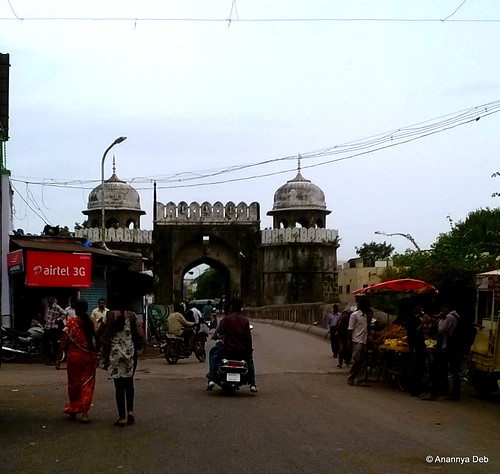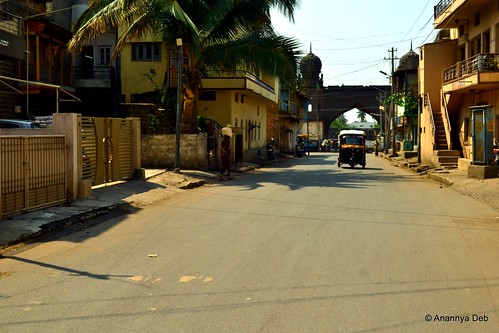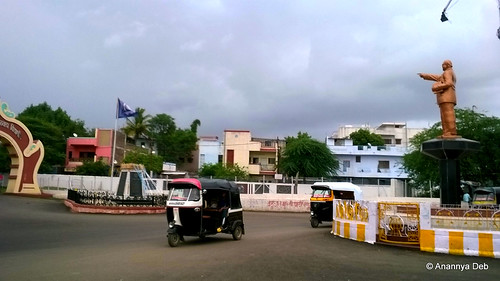The walled city in India can be found across the country. Their age varies from the ancient (Harappan age) to the modern (British age). But the physical walled city disappears in no time. As populations rise, people spill over to live outside the city. Walls are demolished and the city area expanded to cover the new colonies. And every now and them, some superior power comes in and conquers the city and in the process of leaving one’s mark, the conqueror will create a new walled city and the old one will either be subsumed into the new one or be simply abandoned. Delhi has had its share of walled cities and one can easily remember the dynasties that ruled Delhi by looking at the listing of all those sites.
In post-independence India, the crush of ever increasing population, both through higher birthrates and even higher migrations has made these walls and gates an impediment to urban expansion and renewal. Bombay lost its walls in the 19th century itself when the British increased their holdings there. In the soot and grime of the city, these old walls look no different from the decay and dilapidation of urban housing, the only difference being that the more modern urban structures, one can say, can collapse on their own, given the quality of civil engineering and materials used these days. The old walls, however, still remain and will continue to remain till someone takes a stick of dynamite and blows them up. Remember, these walls were meant to withstand the blows of battering rams and cannon fire.
The city of Aurangabad came to being in the 17th century with Malik Ambar (a most fascinating gentleman who easily fits into any rags-to-riches story template – I am gathering various literatures about him and will do a post on him and the different places associated with him) and kept evolving with interventions by Emperor Aurangzeb, the various Nizams of Hyderabad and more recently by the local city and state governments. Over this period of evolution, Aurangabad has had over 52 gates. It was not just one large walled city but a network of walled suburbs and mohallas linked to each other through these gates and bridges (puls).
Off the 52 gates, there are four which are on the cardinal points. The gate facing North is obviously called Delhi Gate. In the same manner, the gate facing west (in the picture above) is called Makai or Mecca Gate. There’s a cannon fitted on top of the gate. The biggest threat to the city came from the west, the Marathas. A photographic census of some of the surviving gates of the city are available in this blogpost by Neha Kulkarni (which I found through a Google search).
As a traveler, the fun of visiting old walled cities is to see the shifting age. There is a clear change – in the language, the manners of the shopkeepers, the signboards, the people and of course, the physical cityscape that one gets to see. It is not necessarily cleaner, rather, in most places, it is filthier, more crowded and full of noise. One of the best places to experience this transition is to go look at the markets in the walled cities. The old signboards promising products of days gone by, their descendents doing trade in almost the same products, displayed on their shelves, each item an antique, a relic in itself.
In Bombay itself (above picture), new age designer boutiques occupy the 19th century structures which have been given a nice coat of paint. Sharing a street with a synagogue which is a regular stop on the popular Kalaghoda Heritage Walk, these designer boutiques try to blend in with retro interiors, shop lighting and their display signs, all of which designed with excruciating detail. Had they been located in the more modern malls, they would obviously have taken a different approach to their shops.
In the Deccan Peninsula, my favourite historical haunt, there are a number of walled cities which live two lives – Bijapur (I wrote about Bijapur’s twin identities last year), Bassein / Vasai, Hyderabad, Belgaum, Pune, Ahmadnagar and so on.
I really enjoyed exploring the old parts of Bijapur, especially streets like these – a typical gate at the end of the street and extremely quaint houses lined on both sides. While the gate in the distance is from the 16th century, the houses themselves are more recent – early 20th century – a very clear example of the continuous evolution of a city.
Back in Aurangabad, while walking, I came across this junction (picture below) where Dr BR Ambedkar stands tall and points the way to the university which is named after him. And on the entrance is a gate. This gate serves as a different transition point, I suppose. It takes you from the big bad world into the dreamy world of students and their lives.
The 52 gates of Aurangabad does not include this gate though. But it should. There is nothing which says modern day structures cannot be considered as part of the history.











